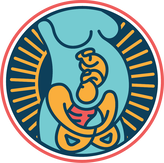|
Many times I've been at births where the nurse or midwife or OB says to my client "Did you take a birth class?" only to follow it up with "Did you learn how to push?" I always find this question so interesting because in an unmedicated birth, pushing has the potential to be an involuntary response. The mass of muscle that has collected at the top of the uterus has been building up, harnessing its strength and power for the very moment when the baby has angled its head just right to fit through the narrow space at the mid pelvis and then dropped a bit lower to begin extending its head under the pubic bones. The uterus has been waiting for this!
But there is this myth out there that people have to be trained in how to push their babies out. And yes, many times some guidance can be very helpful. There are a few times when Valsalva pushing may be a useful option - if a medicated labor decreases the ability to feel the pressure of the baby descending, if spontaneous pushing in a medicated or unmedicated birth does not lead to progress (after significant time and changing of positions, not just one or two contractions), or if a concern about the baby's well being is requiring the second stage to move along faster (more on this later). However, if all is going well and the laboring person has enough sensation to feel what is happening in their body, there are some clear reasons why someone may be better off pushing on their own. Directed pushes - when a deep inhale is taken and while holding the breath, the laboring person pushes for ten seconds, then repeats this again for a total of three "pushes" during the length of one contraction - are extremely strong which can be helpful for expediting the pushing phase when there is a great concern about the baby's well being. Research is mixed on whether or not it decreases the length of the second stage of labor. These pushes can damage the ligaments of the perineal area (see our previous post about keeping the perineum intact) which can complicate the healing process postpartum and potentially lead to pelvic floor dysfunction such as prolapse and incontinence and decreased bladder capacity. While this mode of pushing is usually stalled, as the baby's head begins to crown, in an effort to protect the superficial perineal muscles (and therefore prevent or minimize "tearing") , the damage to the underlying structures is already done at this point. This directed pushing - also known as Valsalva pushing - can also lead to extreme headaches, burst blood vessels in the eyes, decreased blood flow to the baby, and a subsequent need for an oxygen mask for the laboring person. If a baby was in distress during the pushing phase of the second stage, some providers encourage Valsalva pushing to expedite the labor process. However, because this decreases blood flow to the placenta, it may actually further encourage distress in the baby. Research advises giving the baby a rest from pushing, skipping pushing during a few contractions, and possibly continuing then to push only with every other or every three contractions. Spontaneous pushing - which is often more of an exhalation followed by a push that may last five to six seconds, possibly done twice during the length of one contraction - has far less intense pressure placed immediately upon the perineal structures. This allows the muscles to relax with the force of pressure rather than respond by tightening. In addition, the pressure is more directly focused on the vagina and anterior portion of the perineal area which may lessen the risk of tearing. It is also noted that spontaneous pushing may lead to better APGAR scores for newborns as well as less maternal fatigue (which has the potential to affect maternal/fetal bonding and breastfeeding). In conclusion, the research clearly shows benefits to spontaneous pushing yet it appears that hospital staff is not always on board. This means that a discussion of pushing techniques is an important discussion to have with one's provider prior to reaching the second stage of labor. Although some may choose to add a desire for spontaneous pushing into a written birth plan, nothing can replace the verbal reminder to a provider that the research shows spontaneous pushing is the way to go in a low risk scenario. Sources Cited: Calais-Germain, Blandine. The Female Pelvis: Anatomy & Exercises. Eastland Press, 2003. Gulay, Yildirim, Nezihe Kizilkaya Beji. "Effects of Pushing Techniques in Birth on Mother and Fetus: A Randomized Study. Birth 2008; 35;1: 25-30. Hamilton, Cathy. "Using the Valsalva technique during the second stage of labor." British Journal of Midwifery 2014. Haseeb Yasmeen A, Alkunaizi Anwar N, Al Turki Haifa, Aljama Fathia, Sobhy Soheir I. "The impact of valsalva's versus spontaneous pushing techniques during second stage of labor on postpartum maternal fatigue and neonatal outcome." Saudi Journal of Medicine and Medical Sciences 2014; 2:2:101-105. Prins M, Boxem J, Lucas C, Hutton E. "Effect of spontaneous pushing versus Valsalva pushing in the second stage of labour on mother and fetus: a systematic review of randomised trials." BJOG 2011;118:662–670. SImpson, Kathleen Rice. "When and How to Push: Providing the Most Current Information About Second-Stage Labor to Women During Childbirth Education." The Journal of Perinatal Education 2006; 15(4): 6-9.
0 Comments
Leave a Reply. |
AuthorAs the Philadelphia birth world blooms bigger and brighter, I think it's time I start putting some of the insightful questions I've received and information I've research into a public journal. I hope you'll find this inspiring, empowering, and totally enjoyable. Archives
February 2021
Categories |

 RSS Feed
RSS Feed